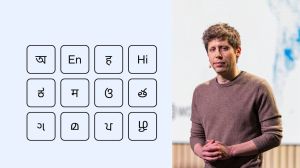Now,a robotic hand to hold hands of loved ones over Internet
A robotic hand that allows a person to hold the hand of his loved ones over the Internet with the help of an electronic wristband has been developed by scientists in Hong Kong.
A robotic hand that allows a person to hold the hand of his loved ones over the Internet with the help of an electronic wristband has been developed by scientists in Hong Kong.
The cyber-hand allows people talking over the Internet to experience the sensation of touch.
According to the developers at the Chinese University,the hand works by using the electrical impulses generated by muscles as they contract.
These signals are picked up by a sensor — called an electromyograph worn like a watch on the forearm of the person making the movements — and sent to the computer which maps them with muscle movements.
The information is then transmitted over the Internet to the receiving computer,where the signals are translated into instructions for the robotic hand which carries out the same hand movement.
The electronic hand can shake hands,hold things and give signs for ‘OK’ and ‘peace’,the Daily Mail reported.
Asserting that “the robotic hand is able to almost instantly imitate the original motion of the human hand and offer the feeling of touch,” lead researchers Liu Yunhui said: “At this moment the function is not perfect. It can’t copy exactly,partly because the robot hand is different from the human hand in terms of degree of freedom of movement it has.”
“There are also few errors such as delays in processing and mechanical problems,” he said.
Pointing out that money is the main obstacle in the further improvement of the hand,Liu said: “Our project target was to produce a toy. It was intended to be low cost and so there were constraints because of the money we could spend.”
“If you want high dexterity it is possible,but you need more motors and you have to spend more money,” he asserted.
On the design of the hand,Liu said: “Prototypes of the hand look unappealingly.”
“But enhancements to make it more human-like in appearance and warm and soft to touch are to be added soon,he said and added: “We are talking to a manufacturer about designing a more human-like hand from silicon rubber which we hope to have within the next month.”
The original intention of the research team had been to develop something which could help the elderly keep in touch with their families,said Liu.
“Although they can show their care through phone calls,physical touch is still a better way to express love. With the system,elderly people and their children and grandchildren can touch and hold hands via the Internet and show affection directly”.
He claims that the system could even be developed to remotely monitor stroke patients undergoing rehabilitation or allow stroke patients to carry out hand physiotherapy in their home rather than travelling to hospital.
Liu said in the future it may be possible to apply this technology to a full humanoid robot,not just a body part,which could copy the movements of someone sitting at a computer.



- 01
- 02
- 03
- 04
- 05




























